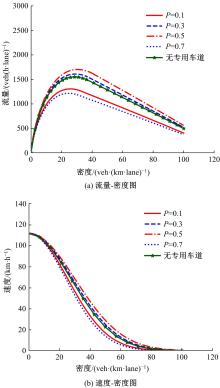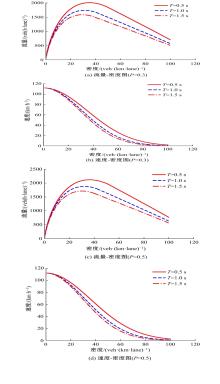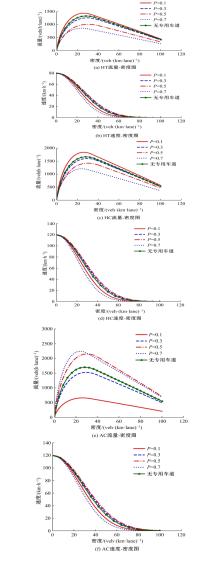Journal of Jilin University(Engineering and Technology Edition) ›› 2023, Vol. 53 ›› Issue (7): 2043-2052.doi: 10.13229/j.cnki.jdxbgxb.20211007
Traffic flow characteristics of six⁃lane freeways with a dedicated lane for automatic cars
Liu YANG1,2( ),Chuang-ye WANG1,2,Meng-yan WANG1,2,Yang CHENG3
),Chuang-ye WANG1,2,Meng-yan WANG1,2,Yang CHENG3
- 1.National Engineering Laboratory of Highway Maintenance Technology,Changsha University of Science & Technology,Changsha 410114,China
2.School of Traffic and Transportation Engineering,Changsha University of Science & Technology,Changsha 410114,China
3.Department of Civil and Environmental Engineering,University of Wisconsin?Madison,Madison 53706,United States
CLC Number:
- U412
| 1 | Bansal P, Kockelman K M. Forecasting Americans' long-term adoption of connected and autonomous vehicle technologies[J]. Transportation Research Part A, 2017, 95: 49-63. |
| 2 | Ye L, Yamamoto T. Impact of dedicated lanes for connected and autonomous vehicle on traffic flow throughput[J]. Physica A: Statistical Mechanics and its Applications, 2018, 512(11): 588-597. |
| 3 | 魏修建, 胡荣鑫, 苏航, 等. 双车道自动-手动驾驶汽车混合交通流博弈模型及其仿真[J]. 系统工程, 2018, 36(11): 97-104. |
| Wei Xiu-jian, Hu Rong-xin, Su Hang, et al. Mixed traffic flow game model and simulation of automatic and manual driving vehicle in two-lane condition[J]. Systems Engineering, 2018, 36(11): 97-104. | |
| 4 | Chen Shu-kai, Wang Hua, Meng Qiang. Designing autonomous vehicle incentive program with uncertain vehicle purchase price[J]. Transportation Research Part C, 2019, 103(6): 226-245. |
| 5 | Lin Xiao, Wang Meng, Arem B V. Traffic flow impacts of converting an HOV lane into a dedicated CACC lane on a freeway corridor[J]. IEEE Intelligent Transportation Systems Magazine, 2020, 12(1): 60-73. |
| 6 | Chen Zhi-bin, He Fang, Zhang Li-hui, et al. Optimal deployment of autonomous vehicle lanes with endogenous market penetration[J]. Transportation Research Part C, 2016, 72(11): 143-156. |
| 7 | Ivanchev J, Knoll A, Zehe D, et al. Potentials and implications of dedicated highway lanes for autonomous vehicles[J]. arXiv: Multiagent Systems, 2017: 1-12. |
| 8 | Ma Ke, Wang Hao. Influence of exclusive lanes for connected and autonomous vehicles on freeway traffic flow[J]. IEEE Access, 2019, 7: 50168-50178. |
| 9 | Yu H, Tak S, Park M, et al. Impact of autonomous-vehicle-only lanes in mixed traffic conditions[J]. Transportation Research Record, 2019, 2673(9): 430-439. |
| 10 | 孙玲, 张静, 周瀛, 等. 车路协同环境下自动驾驶专用车道入口区域设计[J]. 公路交通科技, 2020, 37(): 122-129. |
| Sun Ling, Zhang Jing, Zhou Ying, et al. Entrance area design of autonomous driving lane under vehicle-road collaboration environment[J]. Highway Traffic Technology, 2020, 37(Sup.1): 122-129. | |
| 11 | 秦严严, 王昊, 王炜, 等. 自适应巡航控制车辆跟驰模型综述[J]. 交通运输工程学报, 2017, 17(3): 121-130. |
| Qin Yan-yan, Wang Hao, Wang Wei, et al. Review of car-following models of adaptive cruise control[J]. Journal of Traffic and Transportation Engineering, 2017, 17(3): 121-130. | |
| 12 | Li Tie-nan, Chen Dan-jue, Zhou Hao,et al. Car-following behavior characteristics of adaptive cruise control vehicles based on empirical experiments[J]. Transportation Research Part B, 2021, 147: 67-91. |
| 13 | Treiber M, Hennecke A, Helbing D. Congested traffic states in empirical observations and microscopic simulations[J]. Physical Review E, Statistical Physics, Plasmas, Fluids, and Related Interdisciplinary Topics, 2000, 62(2): 1805-1824. |
| 14 | 蒋阳升, 王思琛, 高宽, 等. 混入智能网联车队的混合交通流元胞自动机模型[J]. 系统仿真学报, 2021,34(5): 1-8. |
| Jiang Yang-sheng, Wang Si-chen, Gao Kuan, et al. Cellular automata model of mixed traffic flow composed of intelligent connected vehicles' platoon[J]. Journal of System Simulation, 2021,34(5):1-8. | |
| 15 | 陈永, 张薇. 高速跟驰交通流动力学模型研究[J]. 物理学报, 2020, 69(6): 136-148. |
| Chen Yong, Zhang Wei. Dynamic model of high speed following traffic flow[J]. Acta Physica Sinica, 2020, 69(6): 136-148. | |
| 16 | Ma Xiao-liang. A neural-fuzzy framework for modeling car-following behavior[C]∥IEEE International Conference on Systems, Man and Cybernetics, Taipei, China, 2006: 1178-1183. |
| 17 | Wiedemann R. Simulation of Road Traffic in Traffic Flow[R]. Karlsruhe: University of Karlsruhe(TH), 1974. |
| 18 | 王殿海, 金盛. 车辆跟驰行为建模的回顾与展望[J]. 中国公路学报, 2012, 25(1): 115-127. |
| Wang Dian-hai, Jin Sheng. Review and outlook of modeling of car following behavior[J]. China Journal of Highway and Transport, 2012, 25(1): 115-127. | |
| 19 | 徐桃让, 姚志洪, 蒋阳升, 等. 智能网联车环境下考虑反应时间影响的基本图模型[J]. 公路交通科技, 2020, 37(8): 108-117. |
| Xu Yao-rang, Yao Zhi-hong, Jiang Yang-sheng, et al. Fundamental diagram model of considering reaction time in environment of intelligent connected vehicles[J]. Journal of Highway and Transportation Research and Development, 2020, 37(8): 108-117. | |
| 20 | 王雪松, 孙平, 张晓春, 等. 基于自然驾驶数据的高速公路跟驰模型参数标定[J]. 中国公路学报, 2020, 33(5): 132-142. |
| Wang Xue-song, Sun Ping, Zhang Xiao-chun, et al. Calibrating car-following models on freeway based on naturalistic driving data[J]. China Journal of Highway and Transport, 2020, 33(5): 132-142. | |
| 21 | 李志伟. 智能网联车辆与普通车辆混合车流交通状态估计方法研究[D]. 南京: 东南大学交通运输工程学院, 2017. |
| Li Zhi-wei. Study on methods of traffic estimation under connected and autonomous vehicles and manual vehicles mixed traffic flow[D]. Nanjing: School of Transportation Southeast University, 2017. |
| [1] | Sui-ning ZHENG,Rui HE,Tian-yu LU,Zi-yi XU,Hua-xin CHEN. Preparation and evaluation of RET/rubber composite modified asphalt and asphalt mixture [J]. Journal of Jilin University(Engineering and Technology Edition), 2023, 53(5): 1381-1389. |
| [2] | Hai-bin WEI,Shuan-ye HAN,Hai-peng BI,Qiong-hui LIU,Zi-peng MA. Intelligent sensing road active ice and snow removal system and experimental technology [J]. Journal of Jilin University(Engineering and Technology Edition), 2023, 53(5): 1411-1417. |
| [3] | Fan YANG,Chen-chen LI,Sheng LI,Hai-lun LIU. Numerical simulation of continuously reinforced concrete pavement with double⁃layer reinforcement under effect of temperature shrinkage [J]. Journal of Jilin University(Engineering and Technology Edition), 2023, 53(4): 1122-1132. |
| [4] | Bo-wen GUAN,Wen-jin DI,Fa-ping WANG,Jia-yu WU,Shuo-wen ZHANG,Zhi-xun JIA. Damage of concrete subjected to sulfate corrosion under dry⁃wet cycles and alternating loads [J]. Journal of Jilin University(Engineering and Technology Edition), 2023, 53(4): 1112-1121. |
| [5] | Zhuang-zhuang LIU,You-wei ZHANG,Peng-yu JI,Abshir Ismail Yusuf,Lin LI,Ya-zhen HAO. Study on heat transfer characteristics of electric heating snow melting asphalt pavement [J]. Journal of Jilin University(Engineering and Technology Edition), 2023, 53(2): 523-530. |
| [6] | Rui-fa LUO,Hui-jun HAO,Tao-rang XU,Qiu-fan GU. Fundamental diagram model of mixed traffic flow of connected and automated vehicles considering vehicles degradations and platooning intensity [J]. Journal of Jilin University(Engineering and Technology Edition), 2023, 53(2): 405-412. |
| [7] | Hai-bin WEI,Zi-peng MA,Hai-peng BI,Han-tao LIU,Shuan-ye HAN. Conductive rubber composite pavement paving technology based on mechanical response analysis method [J]. Journal of Jilin University(Engineering and Technology Edition), 2023, 53(2): 531-537. |
| [8] | Cheng-lin SHI,Yong WANG,Chun-li WU,Wen-zhu SONG. Modification of calculation method for active earth pressure on embankment retaining wall [J]. Journal of Jilin University(Engineering and Technology Edition), 2022, 52(6): 1394-1403. |
| [9] | Qing-lin GUO,Qiang LIU,Chun-li WU,Li-li LI,Yi-ming LI,Fu-chun LIU. Local temperature field and healing level of crack in conductive asphalt and mixture [J]. Journal of Jilin University(Engineering and Technology Edition), 2022, 52(6): 1386-1393. |
| [10] | Yu-quan YAO,Jian-gang YANG,Jie GAO,Liang SONG. Optimal design on recycled hot⁃mix asphalt mixture based on performance⁃cost model [J]. Journal of Jilin University(Engineering and Technology Edition), 2022, 52(3): 585-595. |
| [11] | Quan-ping XIA,Jiang-ping GAO,Hao-yuan LUO,Qi-gong ZHANG,Zhi-jie LI,Fei YANG. Low⁃temperature performance of composite modified hard asphalt used in high modulus asphalt concrete [J]. Journal of Jilin University(Engineering and Technology Edition), 2022, 52(3): 541-549. |
| [12] | Fen YE,Shi-yuan HU. Mechanical properties of ultra⁃thin overlay considering load transfer capacity of old cement pavement joints [J]. Journal of Jilin University(Engineering and Technology Edition), 2022, 52(11): 2636-2643. |
| [13] | Xiao-he YU,Rong LUO,Zi-yao LIU,Ting-ting HUANG,Yu SHU. Numerical simulation of humidity field of typical cracks in asphalt pavement [J]. Journal of Jilin University(Engineering and Technology Edition), 2022, 52(10): 2343-2351. |
| [14] | Yan-hai YANG,Hong CUI,Ye YANG,Huai-zhi ZHANG,He LIU. Effect of freeze-thaw cycle on performance of unsaturated emulsified asphalt cold recycled mixture [J]. Journal of Jilin University(Engineering and Technology Edition), 2022, 52(10): 2352-2359. |
| [15] | Yan-feng JIA,Da-yi QU,Lu LIN,Rong-han YAO,Xiao-long MA. Coordinated speed control of connected mixed traffic flow based on trajectory [J]. Journal of Jilin University(Engineering and Technology Edition), 2021, 51(6): 2051-2060. |
|
||













